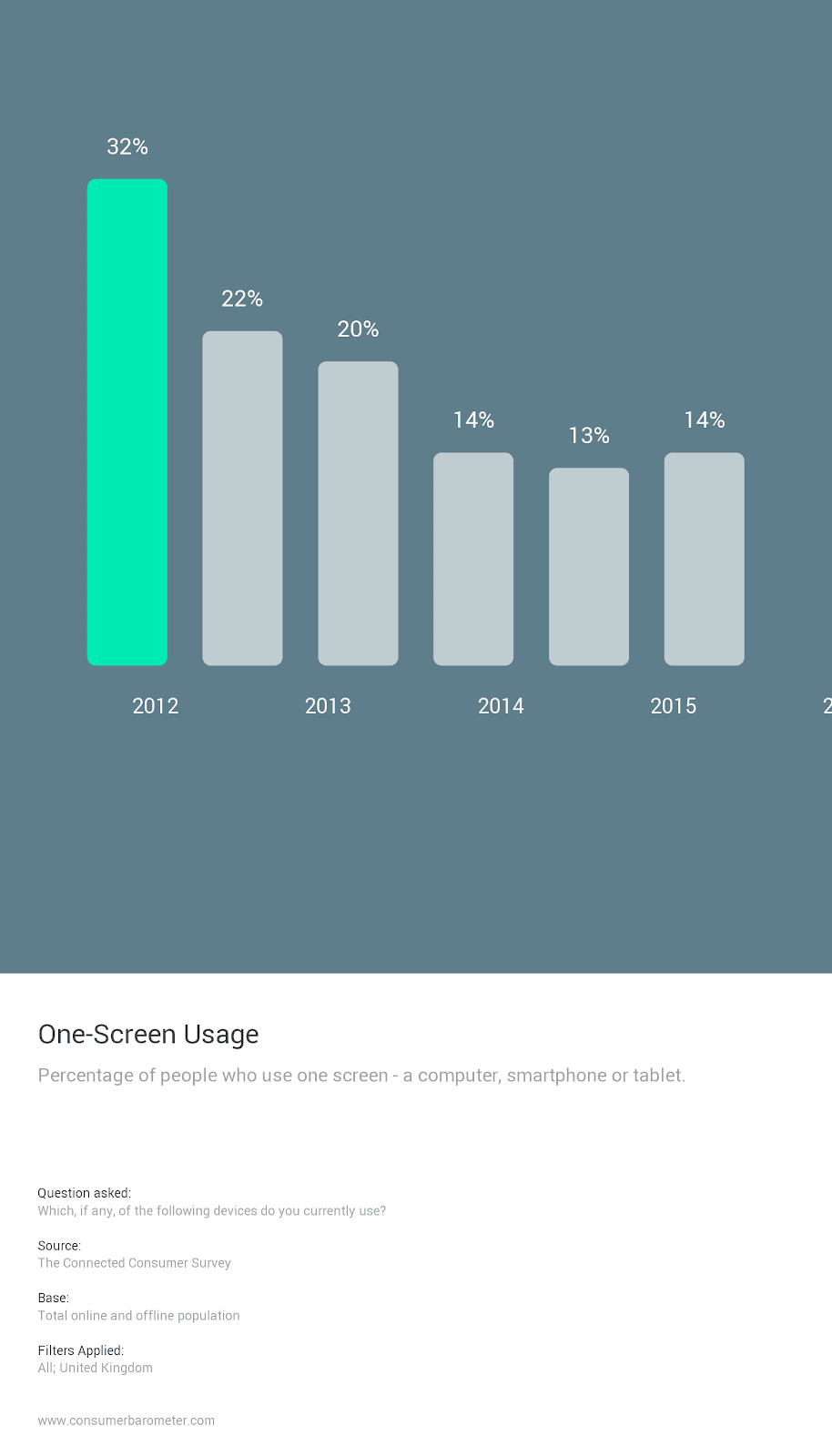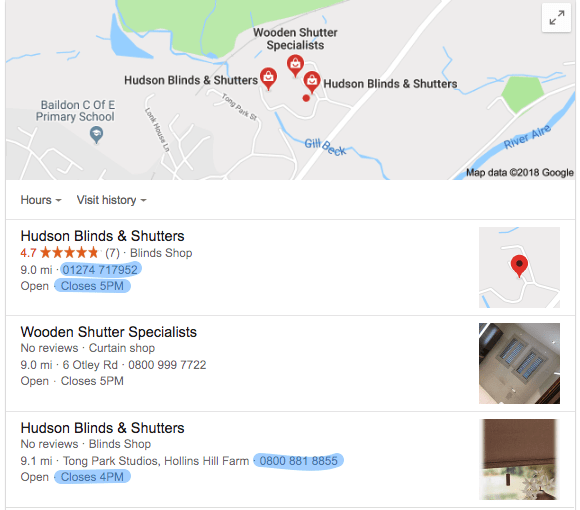While it’s no secret that mobile usage surpassed desktop usage in 2015, another fact that often goes unnoticed is the change in user behavior in terms of the number of devices they use.
According to Google’s Consumer Barometer, the number of users who just use a single device to complete a journey has decreased from 32 percent in 2012, to just 14 percent in 2017.

This poses new challenges for local businesses, as users move between devices their search and discovery experiences will differ as parts of the Local Pack and local algorithms are weighted differently, namely the proximity of businesses to a user location.
As the guide has already established, NAP consistency is an important part of Google’s local and Local Pack algorithms, and building citations with a consistent NAP to your Google My Business listing and listed online addresses can influence your local rankings.
However, having a consistent NAP is also important to the user journey as online directories and social bookmarking sites aren’t just used by Google, they’re used by humans too.
When the User Journey Starts
A lot of people consider the user journey and brand experience to start when the user makes the first inquiry or spends significant time on a company’s website.
However, the journey starts a lot sooner.
Think with Google data shows that there are five touchpoints that, more often than not, lead to a purchase/affirmative site action:
- Used a search engine.
- Visited a store or other location.
- Visited a retailer website or app.
- Visited another website or app.
- Used a map.
The user journey starts when they first see your brand either in search results listing, in the Local Pack, on a map, or at your physical brick-and-mortar store.
Local search is a crucial part of this journey and is even more important given that up to 78 percent of local-intent mobile searches result in an offline store visit within 24 hours.
This is where the consistent NAP becomes important, because users need consistent information in order to progress their journey. A lot of the time we make an assumption that users find our local businesses and brands through our websites, our guest posts and outreach, and our Google My Business listings.
Users, however, find our brand through a variety of online portals, including the directories where we build our citations and listings.
Influencing the User Journey at a Search Stage
When users are performing their first searches, this is your first opportunity to make an impression and be a part of the user journey.
If you’re appearing prominently in the Local Pack or within the SERPs, you want your users to click through to content that both provides value and satisfies their user intent.
Lazy Local Pages Help Nobody
In a lot of cases, when a website “localizes” it means the generation of local content and local pages. These are executed with varying degrees of effort, care, and detail, but ultimately lazy local pages help nobody.
A lazy local page is in effect a doorway page, a thin page that offers little value to the user and has the sole purpose of trying to rank for local search terms.
Google doesn’t like doorway pages (due to them offering poor user experience) and rolled out a doorway page “ranking adjustment” algorithm in 2015.
The Possum update in 2016 also went some way to tackling poor quality and spam, but this is a tactic that has been persisted with and in a lot of verticals they are still effective (until something better comes along).
Google’s official support documentation defines doorways as:
Sites or pages created to rank highly for specific search queries. They are bad for users because they can lead to multiple similar pages in user search results, where each result ends up taking the user to essentially the same destination. They can also lead users to intermediate pages that are not as useful as the final destination.
Even if you rewrite all the content on these pages making sure they’re not duplicate, but they all carry the exact same message just with a different city targeted, they offer no value at all.
Google can see through this, and users will be left dissatisfied.
Creating Good Local Value Pages
Admittedly, it’s a lot easier for companies that have physical brick-and-mortar stores in the locations that they want to target to create local pages with high value.
But this doesn’t mean that it can’t be done for companies offering an intangible product or service with a local focus.
Google’s Search Quality Rater Guidelines define content in two parts:
- The main content.
- The supporting content.
This is the way you should look at local search.
When someone in London searches for [plumbers in london], Google has to break down the query into both main and supporting sections, as well as look for intent.
- “plumbers” the main part of the query, the intent is that the user is looking for a plumber/plumbing service.
- “in london” the supporting element, the user wants the plumber to be local.
From this, Google retrieves relevant results with weighting and personalization given to the local intent of the query.
The main content of your website should reflect the product/services that you offer, with supporting content elements adding value and topical relevance around the location.
This can be implemented in a non-commercial way through the blog, as guides, or as resources.
NAP Consistency
As mentioned before, NAP consistency is important as the directory listings and citations we build aren’t just used by search engines. Potential customers find them, too.
An inconsistent or inaccurate NAP can lead to frustrated users, and potentially lost leads.
Common Reasons for Inconsistent NAP
From experience, inconsistent NAP can be caused by a number of human errors and business changes, including:
- Changing business address and not updating previously built citations, directory listings, etc.
- Having a different store address to the company registered address and using both online.
- Generating different phone numbers for attribution tracking purposes.
Not only can all of the above cause issues for your local SEO, they can also cause a number of user experience issues – and poor user experience leads to loss of sales and damage to your brand.
User experience also extends beyond the Local Pack and SERPs to your website, how the local journey is managed, and whether it can satisfy all local intents.
Being able to track and accurately report on the success of marketing activities is vital.
However, there is a case for “over reporting” and “over attribution” in some cases, especially when it comes to local SEO.
Google Local Pack: User Experience & Attribution
Google’s Local Pack runs on a different algorithm to the traditional organic search results, and is heavily influenced by user location when making the search.
Google My Business has an attribution problem, and more often than not a lot of clicks from GMB listings are classified as direct traffic rather than organic traffic in Google Analytics.
The way around this is to use a parameter:
?utm_source=GMBlisting&utm_medium=organic
The parameter won’t cause NAP/citation consistency issues, so there is nothing to worry about there.
Having a consistent NAP means you’re more likely to appear within the Local Pack, and if you’re in the Local Pack studies have shown that you’re likely to get a high percentage of clicks on the results page.
If you’re likely to get a lot of clicks, it means you’re going to have a lot of users expecting fast loading pages and prominent information to satisfy their search intents.
Directory Attribution
This is a more common problem that I’ve come across working agency side, as well as one I’ve been asked to implement while working client side.
In order to track marketing efforts, I’ve known organizations to generate unique phone numbers for every directory that they submit the business to.
- The pros: You can fairly accurately gauge an ROI on your marketing efforts
- The cons: You end up with a lot of published citations with an inconsistent NAP.
Also, a lot of directories like to generate Google My Business listings based off of the data you input, as a sort of “added service”.
This leads to multiple Google My Business listings being generated for individual locations, with different phone numbers and sometimes different map pin locations.
This is bad for user experience, as they’re faced with multiple choices for one location with only one being correct. Such as this example for an online blinds retailer:

It’s the same company in the same retail park but displaying two different phone numbers and two different closing times.
If a user sees both of these, it’s confusing and means they have to take an extra, unnecessary action in order to engage with your business.
Avoiding Spam Marketers
Another common reason I’ve seen businesses use false numbers on directory listings (when building them for SEO purposes) is to avoid the spam phone calls that follow.
While using a false number prevents the spam calls from reaching you, it also prevents genuine customers as well.
We often forget that a lot of things we do “for SEO” can also affect users and their experience with your company.
Getting Local Right
Local searches often represent higher than average conversion rates, as customers seeking out a local product or service are likely to pursue and complete their actions.
That being said, a lot of local businesses are still not taking full advantage of the opportunities in front of them and tying in performance and user satisfaction.
Image Credits
Featured Image: Paulo Bobita
All screenshots: Taken by author
